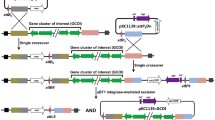Abstract
To facilitate molecular genetic studies of Streptomyces ambofaciens that produces spiramycin, a commercially important macrolide antibiotic used in human medicine against Gram-positive pathogenic bacteria, the conditions for the conjugal transfer of DNA from E. coli to S. ambofaciens were established using a bacteriophage ϕC31 att/int system. The transconjugation efficiency of S. ambofaciens varied with the medium used; the highest frequency was obtained on AS-1 medium containing 10 mM MgCl2 without heat treatment of the spores. In addition, by cloning and sequencing the attB site, we identified that S. ambofaciens contains a single attB site within an ORF coding for a pirin homolog, and its attB site sequence shows 100% nt identity to the sequence of S. coelicolor and S. lividans, which have the highest efficiency in transconjugation using the ϕC31 att/int system.



Similar content being viewed by others
References
Bailey CR, Winstanley DJ (1986) Inhibition of restriction in Streptomyces clavuligerus by heat treatment. J Gen Microbiol 132:2945–2947
Baltz RH (1998) Genetic manipulation of antibiotic-producing Streptomyces. Trends Microbiol 6:76–82
Bierman M, Logan R, O’Brien K, Seno ET, Rao RN, Schoner BE (1992) Plasmid cloning vectors for the conjugal transfer of DNA from Escherichia coli to Streptomyces spp. Gene 116:43–49
Choi SU, Lee CK, Hwang YI, Kinoshita H, Nihira T (2004) Intergeneric conjugal transfer of plasmid DNA from Escherichia coli to Kitasatospora setae, a bafilomycin B1 producer. Arch Microbiol 181:294–298
Engel P (1987) Plasmid transformation of Streptomyces tendae after heat attenuation of restriction. Appl Environ Microbiol 53:1–3
Flett F, Mersinias V, Smith CP (1997) High efficiency intergeneric conjugal transfer of plasmid DNA from Escherichia coli to methyl DNA-restricting streptomycetes. FEMS Microbiol Lett 155:223–229
Fouces R, Rodríguez M, Mellado E, Díez B, Barredo JL (2000) Conjugation and transformation of Streptomyces species by tylosin resistance. FEMS Microbiol Lett 186:319–325
Kieser T, Bibb MJ, Buttner MJ, Chater KF, Hopwood DA (2000) Practical Streptomyces Genetics. The John Innes Foundation, Norwich, UK
MacNeil DJ (1988) Characterization of a unique methyl-specific restriction system in Streptomyces avermitilis. J Bacteriol 170:5607–5612
Matsushima P, Baltz RH (1985) Efficient plasmid transformation of Streptomyces ambofaciens and Streptomyces fradiae protoplasts. J Bacteriol 163:180–185
Matsushima P, Broughton MC, Turner JR, Baltz RH (1994) Conjugal transfer of cosmid DNA from Escherichia coli to Saccharopolyspora spinosa: effects of chromosomal insertions on macrolide A83543 production. Gene 146:39–45
Mazodier P, Petter R, Thompson C (1989) Intergeneric conjugation between Escherichia coli and Streptomyces species. J Bacteriol 171:3583–3585
Motamedi H, Shafiee A, Cai SJ (1995) Integrative vectors for heterologous gene expression in Streptomyces spp. Gene 160:25–31
Paranthaman S, Dharmalingam K (2003) Intergeneric conjugation in Streptomyces peucetius and Streptomyces sp. strain C5: chromosomal integration and expression of recombinant plasmids carrying the chiC gene. Appl Environ Microbiol 69:84–91
Richardson MA, Kuhstoss S, Huber ML, Ford L, Godfrey O, Turner JR, Rao RN (1990) Cloning of spiramycin biosynthetic genes and their use in constructing Streptomyces ambofaciens mutants defective in spiramycin biosynthesis. J Bacteriol 172:3790–3798
Smokvina T, Mazodier P, Boccard F, Thompson CJ, Guerineau M (1990) Construction of a series of pSAM2-based integrative vectors for use in actinomycetes. Gene 94:53–59
Stegmann E, Pelzer S, Wilken K, Wohlleben W (2001) Development of three different gene cloning systems for genetic investigation of the new species Amycolatopsis japonicum MG417-CF17, the ethylenediaminedisuccinic acid producer. J Biotechnol 92:195–204
Voeykova T, Emelyanova L, Tabakov V, Mkrtumyan N (1998) Transfer of plasmid pTO1 from Escherichia coli to various representatives of the order Actinomycetales by intergeneric conjugation. FEMS Microbiol Lett 162:47–52
Acknowledgements
This work was supported by Kyungnam University Foundation Grant, 2006.
Author information
Authors and Affiliations
Corresponding author
Rights and permissions
About this article
Cite this article
Kim, MK., Ha, HS. & Choi, SU. Conjugal transfer using the bacteriophage ϕC31 att/int system and properties of the attB site in Streptomyces ambofaciens . Biotechnol Lett 30, 695–699 (2008). https://doi.org/10.1007/s10529-007-9586-0
Received:
Revised:
Accepted:
Published:
Issue Date:
DOI: https://doi.org/10.1007/s10529-007-9586-0




